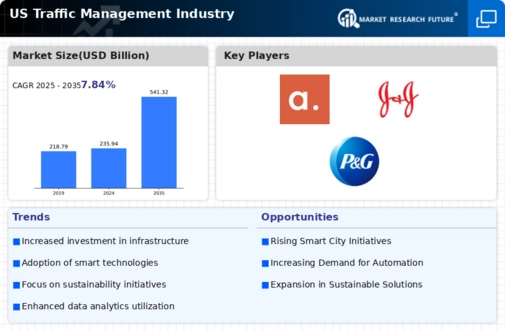Increased Focus on Road Safety
The increased focus on road safety is a pivotal driver for the traffic management market. With traffic-related fatalities on the rise, there is a pressing need for effective traffic management solutions to enhance safety. The US Department of Transportation reported that in 2024, traffic fatalities reached a 16-year high, prompting a national response to improve road safety. This has led to the implementation of advanced traffic management systems, including real-time monitoring and data analytics, to identify and mitigate hazards. As safety becomes a priority for both government agencies and the public, investment in traffic management solutions is likely to grow, further propelling the market.
Urbanization and Population Growth
Urbanization and population growth are significant factors influencing the traffic management market. As more individuals migrate to urban areas, the demand for efficient traffic management solutions intensifies. The US urban population is projected to reach 90% by 2050, leading to increased vehicular traffic and congestion. This trend necessitates the implementation of advanced traffic management systems to accommodate the growing number of vehicles. Furthermore, cities are increasingly adopting smart city initiatives, which integrate traffic management solutions to enhance urban mobility. This shift towards urbanization is likely to drive innovation and investment in the traffic management market.
Government Investments in Infrastructure
Government investments in infrastructure are a critical driver for the traffic management market. The US government has allocated substantial funding for transportation infrastructure improvements, with a proposed $1 trillion investment over the next decade. This funding aims to modernize roadways, enhance public transit systems, and implement smart traffic management solutions. Such investments are likely to create a more efficient transportation network, reducing travel times and improving safety. Additionally, the focus on upgrading aging infrastructure is expected to stimulate demand for advanced traffic management systems, thereby propelling the growth of the traffic management market.
Technological Advancements in Traffic Management
The traffic management market is experiencing a surge in technological advancements, particularly with the integration of artificial intelligence (AI) and machine learning. These technologies enhance traffic flow efficiency and reduce congestion. For instance, AI-driven traffic signal systems can adapt in real-time to changing traffic conditions, potentially improving traffic flow by up to 30%. Moreover, the adoption of connected vehicle technology is expected to grow, with projections indicating that by 2025, over 50 million connected vehicles will be on US roads. This integration of technology not only optimizes traffic management but also contributes to improved safety and reduced emissions, thereby driving growth in the traffic management market.
Environmental Regulations and Sustainability Goals
Environmental regulations and sustainability goals are shaping the traffic management market. Stricter emissions standards and a growing emphasis on reducing carbon footprints are prompting cities to adopt greener traffic management solutions. The US government has set ambitious targets to reduce greenhouse gas emissions by 50% by 2030, which influences transportation policies. Consequently, there is a rising demand for traffic management systems that promote eco-friendly practices, such as optimizing traffic flow to minimize idling and emissions. This focus on sustainability is expected to drive the development and adoption of innovative solutions within the traffic management market.













Leave a Comment